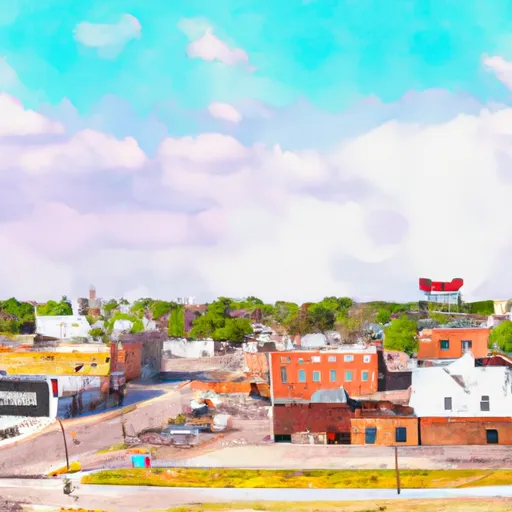-
 Snoflo Premium
Snoflo Premium
Get unlimited access to all our content
With no Ad interruptions! - Start Your Free Trial Login with existing account
Selman
Eden Index
Climate
9.7
•
Recreation
0.3
•
Community
1.5
•
Safeguard
4.3/10

Selman, Oklahoma is a small town located in Harper County, in the southern United States. The climate in Selman is classified as humid subtropical, characterized by hot summers and mild winters. Average high temperatures range from the 90s°F (30s°C) during summer to the 40s°F (4-9°C) in winter. Precipitation is fairly evenly distributed throughout the year, with an annual average of around 25 inches (64 cm).
As for hydrology constituents, Selman is not situated near any large bodies of water. However, it is part of the Red River watershed, which contributes to local groundwater and surface water resources. The town relies on wells for its water supply.
Selman offers several outdoor recreation opportunities for residents and visitors alike. The area is known for its beautiful landscapes and natural attractions. Outdoor enthusiasts can enjoy activities such as hiking, camping, fishing, and hunting in the surrounding areas. The nearby Gloss Mountains provide great opportunities for hiking and wildlife observation. Selman State Wildlife Management Area, located just a short drive away, offers additional outdoor activities, including bird watching and wildlife photography. Overall, Selman, Oklahoma provides a charming location for those seeking outdoor adventures in a scenic setting.
What is the Eden Index?
The Snoflo Eden Index serves as a comprehensive rating system for regions, evaluating their desirability through a holistic assessment of climate health, outdoor recreation opportunities, and natural disaster risk, acknowledging the profound impact of these factors on livability and well-being.
Climate Health Indicator (CHI): 9.7
Selman receives approximately
621mm of rain per year,
with humidity levels near 72%
and air temperatures averaging around
15°C.
Selman has a plant hardyness factor of
6, meaning
plants and agriculture in this region thrive during a short period during spring and early summer. Most
plants will die off during the colder winter months.
By considering the ideal temperature range, reliable water supplies, clean air, and stable seasonal rain or snowpacks, the Climate Health Indicator (CHI) underscores the significance of a healthy climate as the foundation for quality living.
A healthy climate is paramount for ensuring a high quality of life and livability in a region, fostering both physical well-being and environmental harmony. This can be characterized by ideal temperatures, reliable access to water supplies, clean air, and consistent seasonal rain or snowpacks.
Weather Forecast
Streamflow Conditions
Lower Cimarron
Area Rivers
Lower Cimarron
Snowpack Depths
Lower Cimarron
Reservoir Storage Capacity
Lower Cimarron
Groundwater Levels
Recreational Opportunity Index (ROI): 0.3
The Recreational Opportunity Index (ROI) recognizes the value of outdoor recreational options, such as parks, hiking trails, camping sites, and fishing spots, while acknowledging that climate plays a pivotal role in ensuring the comfort and consistency of these experiences.
Access to outdoor recreational opportunities, encompassing activities such as parks, hiking, camping, and fishing, is crucial for overall well-being, and the climate plays a pivotal role in enabling and enhancing these experiences, ensuring that individuals can engage in nature-based activities comfortably and consistently.
Camping Areas
| Campground | Campsites | Reservations | Toilets | Showers | Elevation |
|---|---|---|---|---|---|
| Beaver Point - Fort Supply Lake | None | 2,015 ft | |||
| Supply Park - Fort Supply Lake | None | 1,991 ft | |||
| Doby Springs Park | 18 | 1,975 ft |
Nearby Ski Areas
Catastrophe Safeguard Index (CSI):
The Catastrophe Safeguard Index (CSI) recognizes that natural disaster risk, encompassing floods, fires, hurricanes, and tornadoes, can drastically affect safety and the overall appeal of an area.
The level of natural disaster risk in a region significantly affects safety and the overall livability, with climate change amplifying these risks by potentially increasing the frequency and intensity of events like floods, fires, hurricanes, and tornadoes, thereby posing substantial challenges to community resilience and well-being.
Community Resilience Indicator (CRI): 1.5
The Community Resilience Indicator (CRI) recognizes that education, healthcare, and socioeconomics are crucial to the well-being of a region. The CRI acknowledges the profound impact of these elements on residents' overall quality of life. By evaluating educational resources, healthcare accessibility, and economic inclusivity, the index captures the essential aspects that contribute to a thriving community, fostering resident satisfaction, equity, and social cohesion.

